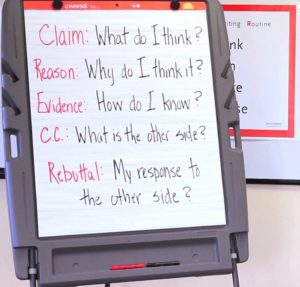Teaching Basic Argument Writing Components

Over the past two years since Keys to Literacy published my Keys to Argument Writing professional development module and the associated training book Keys to Content Writing I am often asked by teachers advice for how to teach argument writing (and opinion for elementary grades). The place to start is to introduce students to the structure of argument/opinion writing.
The first standard of the Common Core Writing Standards is devoted to argument writing. Here is the anchor standard from which Standard #1 for grades K through 12 are based:
WS #1: Write opinions/arguments to support claims in an analysis of substantive topics or texts using valid reasoning and relevant and sufficient evidence.
Sometimes argument writing seems very similar to informational writing (Common Core Writing Standard #2). They both incorporate information, and they have similar basic text structures: They must begin with an introduction that states the topic and end with a conclusion. However, their aims are different and the body of an argument organizes information in a different way.
The purpose of informational writing is to examine and explain previously learned information or new information, and this information is typically organized into paragraphs of main ideas that are “chunked” into topics and sub-topics. That is, the information is presented in categories/sections. The purpose of argument writing is to convince a reader that a point of view is valid or to persuade the reader to take a specific action. Information is used, but it is organized based on these major components of an argument: claim, reason, evidence, counter-claim, and rebuttal.
Here are simple descriptions of these components to share with your students:
- Claim: the position taken by the writer; what the writer is trying to prove or argue
- Reason: provided to support a claim; reasons are supported by evidence
- Evidence: use to support or prove a reason; statistics, facts, quotations, surveys, etc.
- Counterclaim: opposing position, counterargument
- Rebuttal: refutes or disproves the counterclaim; addresses the criticism of the claim
And here’s an even simpler set of questions students can ask themselves to help remember each component:
- Claim: What do I think?
- Reason: Why do I think it?
- Evidence: How do I know (proof)?
- Counterclaim: What is the other side?
- Rebuttal: My response to the other side?
The claim is typically stated in the introduction, and restated again in the conclusion. The information in the body paragraphs is organized as a series of reasons supported by evidence. For arguments that include a counter-claim and rebuttal (a requirement for students in grade seven and beyond), there will be additional paragraphs that represent the counter-claim and rebuttal.
Keys to Literacy has posted a nine-minute video recorded during a teacher training in which I explain the major components of an argument and offer suggestions for teaching them to students. The video, along with several other training video clips is available to the public for free at the Free Resources section of the Keys to Literacy website.
At the same resource site you will find a teacher’s checklist and rubric for giving feedback to students about their argument writing that include items related to the text structure of an argument writing piece.

 Joan Sedita is the founder of Keys to Literacy and author of the Keys to Literacy professional development programs. She is an experienced educator, nationally recognized speaker and teacher trainer. She has worked for over 35 years in the literacy education field and has presented to thousands of teachers and related professionals at schools, colleges, clinics, and professional conferences.
Joan Sedita is the founder of Keys to Literacy and author of the Keys to Literacy professional development programs. She is an experienced educator, nationally recognized speaker and teacher trainer. She has worked for over 35 years in the literacy education field and has presented to thousands of teachers and related professionals at schools, colleges, clinics, and professional conferences.
I have found your lectures and instructions very helpful. Do you have any guidelines on Exposition?
Visit our free videos and webinars where you will find several items related to writing.
What components are there into the claim and evidence rubric?
Some of the things to look for in student argument writing are: Is the claim (position taken) supported with logical reasons and relevant evidence? Are the reasons and evidence presented in an organized way? Is the evidence from sources integrated effectively? Is the rebuttal supported with logical reasons and evidence? Are transitions used to link and to create cohesion among claim, reasons and evidence? Is there a formal style and an objective tone established and maintained throughout the piece?
That was a super helpful resource! I used it to write a paragraph essay on “Elements of Argument”.
Thank you for explaining an argumentive essay. and supportive of me getting started on this essay.
Thanks for the tips..really helpful in writing my assignment in Academic English.
May you send me an example of an argumentative essay and other essay and their example please.
This site has examples of argument essays: https://www.collegeessay.org/blog/argumentative-essay-examples
Amazing 👏
Thank you for better clarity and better simplicity